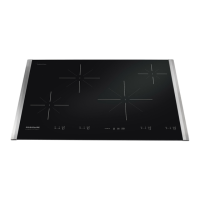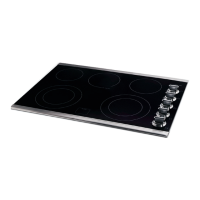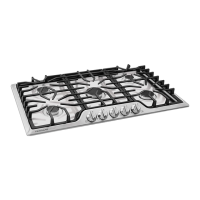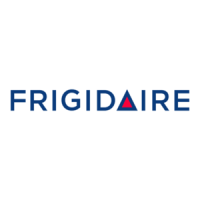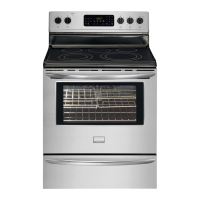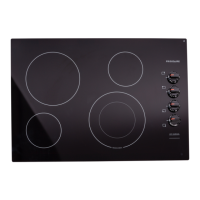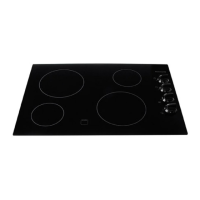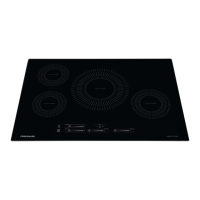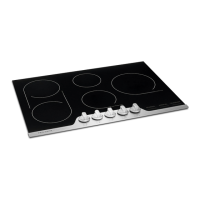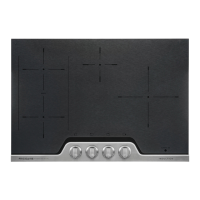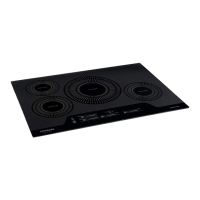
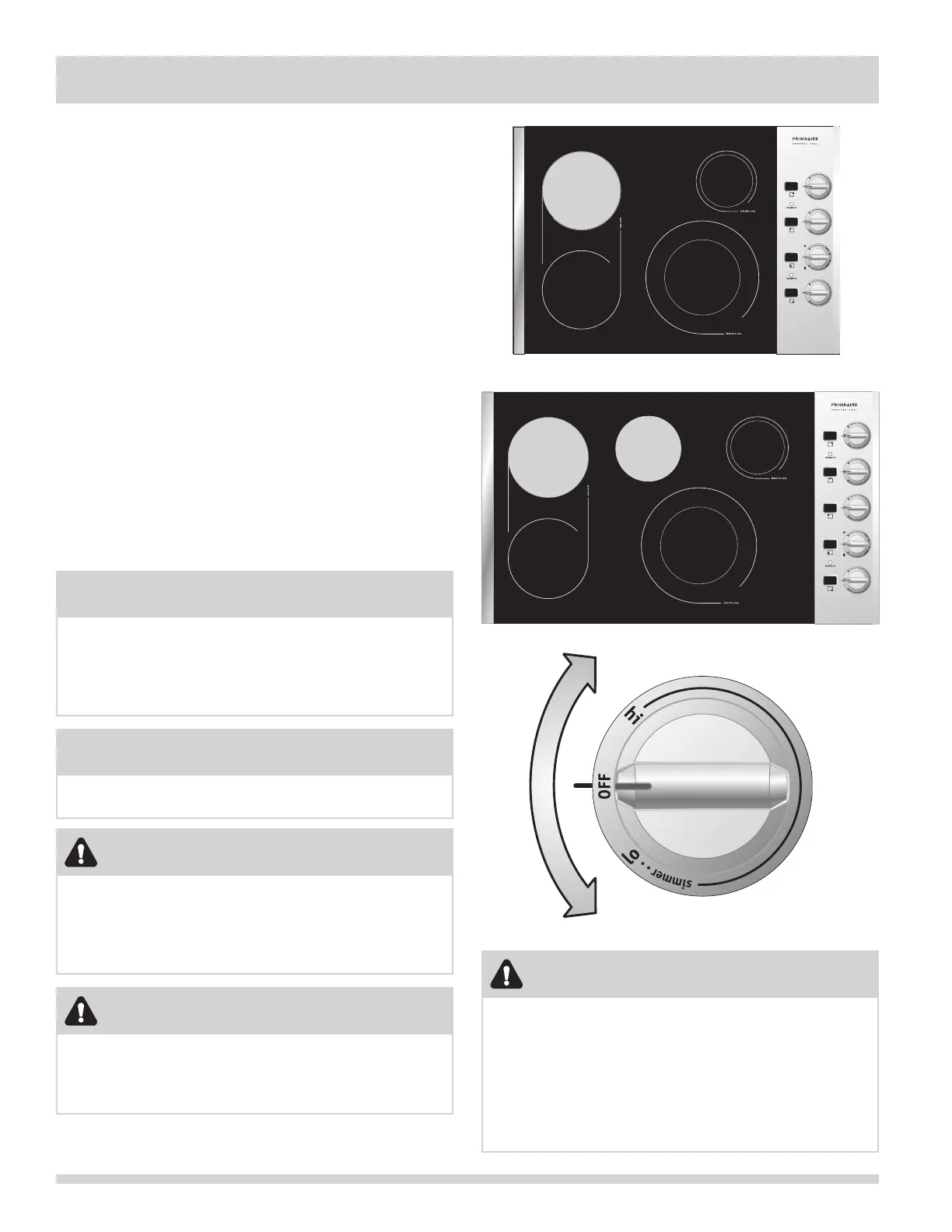 Loading...
Loading...
Do you have a question about the Frigidaire FGIC3666TB and is the answer not in the manual?
| Style | smoothtop |
|---|---|
| Color | black |
| Griddle | no |
| Induction | yes |
| Number of Cooking Zones | 5 |
| Downdraft Vent | no |
| Cooktop Element | 5 |
| Control Type | digital |
| Power Consumption | 3800 watts |
| Voltage | 240 volts |
| Current | 45.2 amperes |
| Depth | 21 1/2 inches |
|---|---|
| Height | 4 2/5 inches |
| Width | 36 5/7 inches |
| Cutout Depth | 20 1/2 inches |
| Cutout Height | 5 inches |
| Cutout Width | 36 3/4 inches |
| Net Weight | 48 pounds |
Guidance on filling and returning the product registration card for new appliances.
Instructions on finding and recording cooktop model and serial numbers for future reference.
Explanation of safety alert symbols like WARNING, CAUTION, and IMPORTANT for hazard awareness.
Essential safety measures including proper installation, servicing, and storage guidelines.
Critical warnings concerning children, leaning on the cooktop, and touching hot surfaces.
Guidelines on appropriate attire, handling grease fires, and using dry pot holders.
Recommendations for cookware and warnings against using protective liners like aluminum foil.
Required disclosure regarding substances known to cause cancer or reproductive harm.
Details on induction features: cooler surface, magnetic detection, pan size adaptation, and efficiency.
Diagram and list identifying each surface element and its corresponding control knob or indicator.
A critical warning that cooking zones may remain hot after being turned off due to residual heat.
Information about the ceramic glass surface and the placement of underlying heating elements.
Explanation of how radiant elements gradually heat, glow red, and cycle on/off.
Diagrams and descriptions detailing the layout of radiant and induction elements for different models.
Overview of the ESEC system, including digital displays and numeric settings for elements.
Guide to using ESEC settings from HIGH to LOW and Simmer for various cooking needs.
Explanation of Power Failure (PF), Hot Element (HE), and Error (Er) messages displayed by the ESEC.
Details on the Power Boost feature for rapid heating of large quantities of food or water.
A chart providing suggested heat settings for different types of cooking processes.
Instructions for using individual radiant surface elements and their controls.
Information about the indicator lights that show when surface elements are active.
Warning against placing plastic items, shakers, or wrappers on the hot cooktop surface.
Warning that aluminum foil melting on the ceramic glass will cause damage.
Reminder that radiant surfaces can remain hot after being turned off, posing a burn risk.
Guide to using the bridge element for rectangular or oval cookware and its controls.
Explanation of symbols indicating front-only or front-and-middle heating for the bridge element.
How to use the bridge element in conjunction with the left rear single element.
Instructions for using induction elements, including the Power Boost feature.
Explanation of how power is distributed between two induction cooking zones.
Advice on managing power levels to optimize cooking when power sharing is active.
Warning that while induction elements don't heat directly, the surface can become hot from cookware.
Requirement for magnetic cookware and testing methods for induction compatibility.
Recommendations for using quality cookware to prevent scratching the ceramic surface.
Explanation that some background noises are normal during induction cooking, especially at high power.
Guidance on minimum and maximum pan sizes to ensure proper contact and heating.
Illustrations showing correct and incorrect cookware placement and properties for induction cooking.
Explanation of how improper cookware affects heating and may cause flashing displays or errors.
Advice on ensuring flat bottoms, proper material, and appropriate pan size for efficient cooking.
Warning against sliding cookware on the ceramic surface to prevent permanent damage.
Reminder to use oven mitts or pot holders when handling hot cookware to prevent burns.
Basic steps for cleaning stainless steel and ceramic glass surfaces, ensuring controls are off and cool.
Detailed advice on cleaning, buffing, and applying protective creme to the ceramic glass surface.
Instructions on how to remove metal markings caused by cookware on the ceramic surface.
Warning that cookware with rough bottoms can scratch or mark the ceramic glass surface.
Prohibition against using the cooktop as a cutting board or general work surface.
Steps for cleaning light soil and methods for removing heavy or burned-on residue using cleaning creme.
Critical warning not to use cooktop cleaner on a hot surface due to hazardous fumes and damage.
Alert about potential health hazards from fumes produced when cleaners contact a hot cooktop.
Instruction to only use non-abrasive pads and specific cleaners designed for ceramic glass.
List of harsh cleaners like bleach, ammonia, and oven cleaners that can damage the cooktop.
Specific warnings regarding the use of aluminum foil and aluminum cookware on the ceramic surface.
Solutions for when the entire cooktop fails to operate, checking fuses, breakers, and power sources.
Troubleshooting steps for elements that do not heat, including power, controls, and cookware checks.
Resolving problems with elements being too hot or not hot enough through setting adjustments.
Addressing issues with food not heating evenly by checking cookware and settings.
Information on minor scratches and cleaning recommendations for the ceramic glass surface.
Solutions for removing metal marks, brown streaks, and specks from the ceramic glass surface.
Guidance on addressing areas of discoloration on the ceramic glass cooktop surface.
Details of what the one-year limited warranty covers for repairs and replacement of defective parts.
A comprehensive list of items and conditions not covered by the appliance warranty.
Legal statements limiting implied warranties and liability for consequential damages.
Instructions and contact information for requesting warranty service within the USA and Canada.
